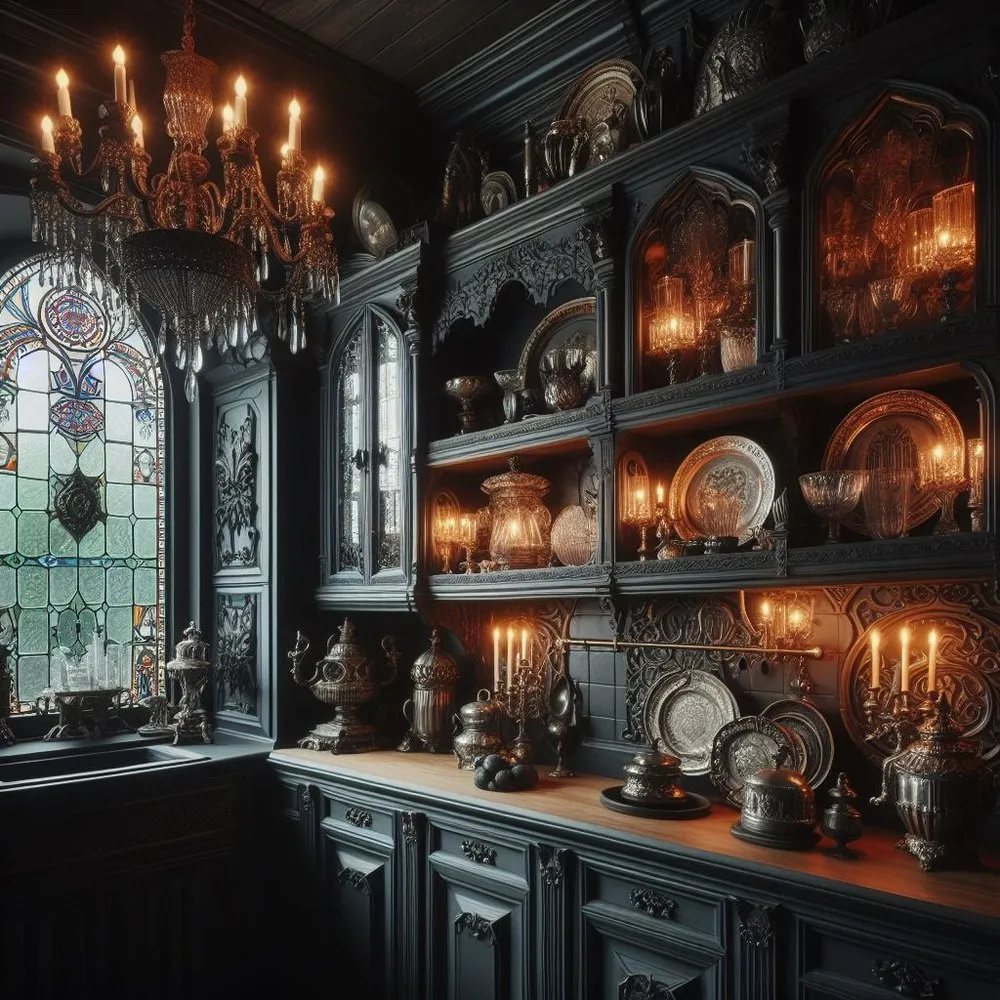What is Gothic Kitchen Decor?
Gothic kitchen decor is a captivating style that embraces dark, dramatic, and mysterious elements. It’s a design aesthetic rooted in the architectural and artistic style of the late medieval period. It’s characterized by its use of rich colors, ornate details, and a sense of history and grandeur. Unlike the bright and airy kitchens that are often popular, a gothic kitchen creates a moody and atmospheric space, perfect for those who appreciate a touch of the macabre and a love for the dramatic. Gothic kitchen decor often incorporates elements like dark wood, wrought iron, and elaborate patterns to evoke a sense of old-world charm and sophistication. This style allows you to express your personality and create a unique, unforgettable space within your home.
The History and Origins
The origins of the Gothic style can be traced back to the 12th century in Europe, particularly in the realm of architecture. Gothic architecture, with its pointed arches, ribbed vaults, and soaring heights, was a radical departure from the preceding Romanesque style. This architectural style was not only beautiful but also showcased the power and prestige of the church and monarchy. The Gothic style quickly spread throughout Europe, influencing not only architecture but also art, sculpture, and decorative arts. As the style evolved, it began to incorporate elements of fantasy and the supernatural. The gothic style emphasizes dramatic lighting, intricate details, and a sense of mystery. Applying this to your kitchen decor will give you a space with rich history and unparalleled visual appeal.
Key Elements of Gothic Style
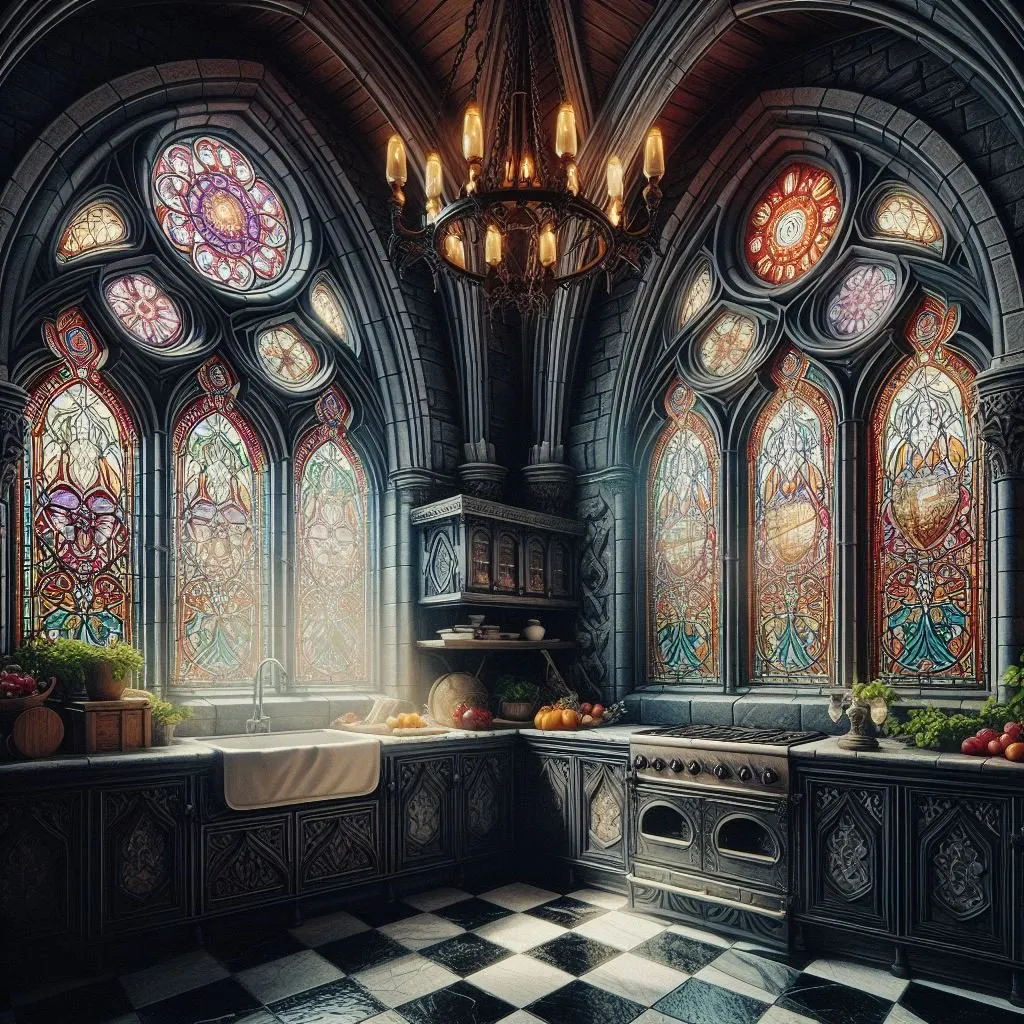
Several key elements define Gothic style. These elements, when implemented in your kitchen, will create a cohesive and visually stunning space. Understanding these elements will allow you to create an authentic Gothic atmosphere. The use of dark color palettes, ornate details, and textured surfaces are central to achieving the gothic look, providing a canvas upon which you can build your design. It’s about embracing the dramatic and creating a space that feels both luxurious and mysterious. Remember that the details matter when trying to capture the essence of Gothic design. By carefully selecting elements and integrating them into your kitchen, you can create a space that reflects your personal style and appreciation for this unique aesthetic.
Dark Color Palettes
Dark, rich colors are a cornerstone of gothic kitchen design. Think deep blacks, charcoal grays, burgundy, deep purples, and forest greens. These colors create a dramatic and moody atmosphere, setting the stage for a truly gothic aesthetic. These dark hues work best when balanced with lighter accents to prevent the space from feeling overwhelmingly dark. You can incorporate lighter colors through your countertops, backsplashes, or metallic accents, ensuring the space feels balanced and inviting. Dark colors offer the space a sense of depth, making your kitchen feel more intimate and luxurious. Consider painting your cabinets or walls in these dark shades, and complement them with lighter furniture to bring out the beauty and drama of the space.
Ornate Details and Designs
Gothic design is all about the details. Ornate carvings, intricate moldings, and elaborate patterns are common features. Look for cabinets with detailed paneling, countertops with elegant edges, and decorative hardware with unique designs. These details add depth, character, and sophistication to your kitchen. Consider incorporating elements like pointed arches, fleur-de-lis motifs, and other Gothic-inspired patterns in your design. These details create visual interest and elevate the overall aesthetic. These decorative details will make your space feel rich and full of character. The more intricate the details, the more authentic your Gothic kitchen will feel, embracing the spirit of the Gothic era.
Textured Surfaces
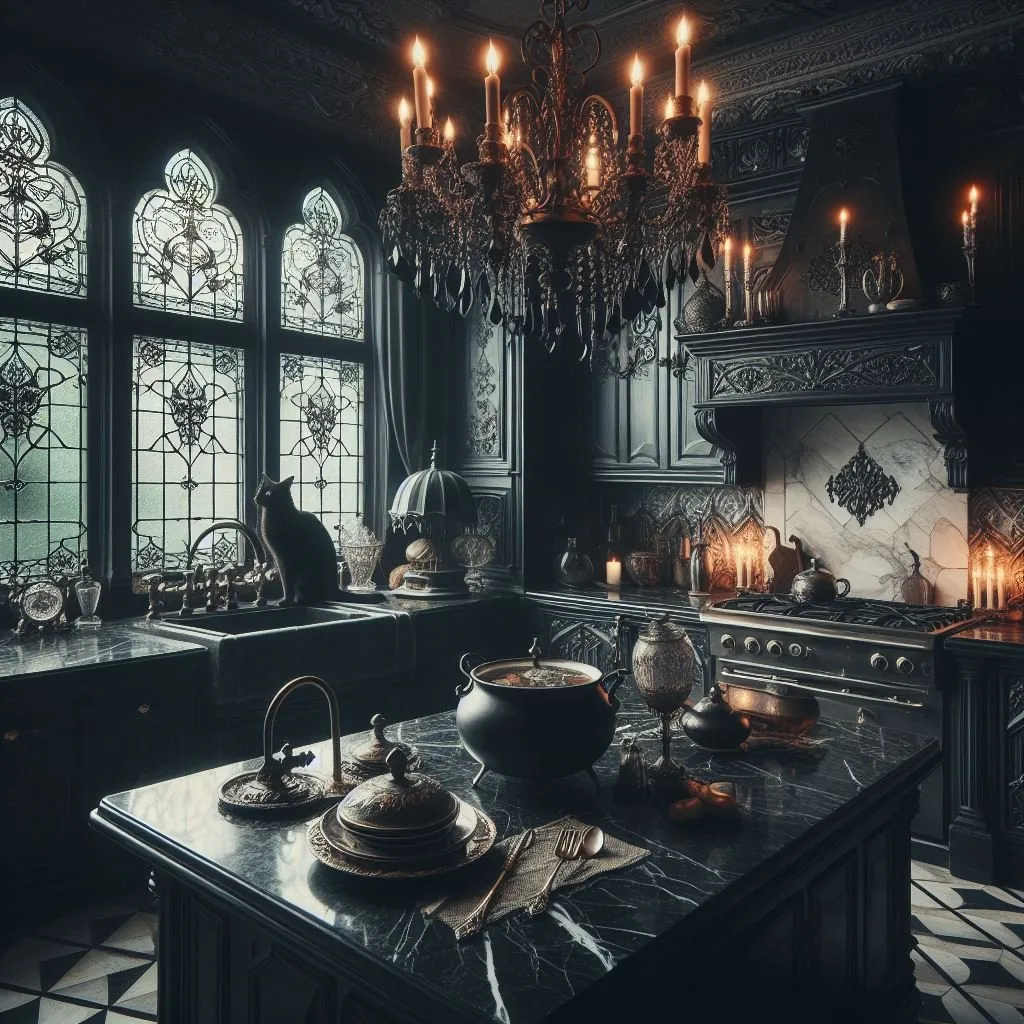
Textures play a crucial role in gothic kitchen decor. They add depth, warmth, and visual interest. Consider incorporating textured materials like stone, brick, and wrought iron. Stone countertops or backsplashes will add a natural, rustic element, while exposed brick walls can create a vintage, industrial feel. Wrought iron accents, such as cabinet handles or light fixtures, introduce a touch of elegance and drama. These various textures create a multi-layered sensory experience. Using different textures is essential to prevent the space from appearing flat or dull. The contrast between the textures will make the space more inviting and dynamic, bringing the Gothic aesthetic to life.
Choosing Your Gothic Kitchen Style
Within the gothic style, there are several variations to choose from, depending on your personal preferences and the overall style of your home. You can customize your gothic kitchen to better suit your taste and existing decor. Some popular options include classic gothic, modern gothic, and rustic gothic. Each style offers a unique take on the gothic aesthetic, allowing you to create a kitchen that is both stylish and reflects your individual taste.
Classic Gothic
Classic gothic style stays true to its historical roots, emphasizing the ornate details and dramatic elements of the Gothic era. It often incorporates dark wood cabinetry, intricate carvings, and elaborate hardware. Expect to see pointed arches, stained-glass accents, and rich, jewel-toned colors like deep reds, emerald greens, and royal purples. This style evokes a sense of grandeur and historical richness, perfect for those who want to fully embrace the gothic aesthetic. The classic style is about creating a space that feels like it’s been transported from a medieval castle. By using authentic materials and detailed craftsmanship, you can recreate the charm and sophistication of the Gothic era.
Modern Gothic
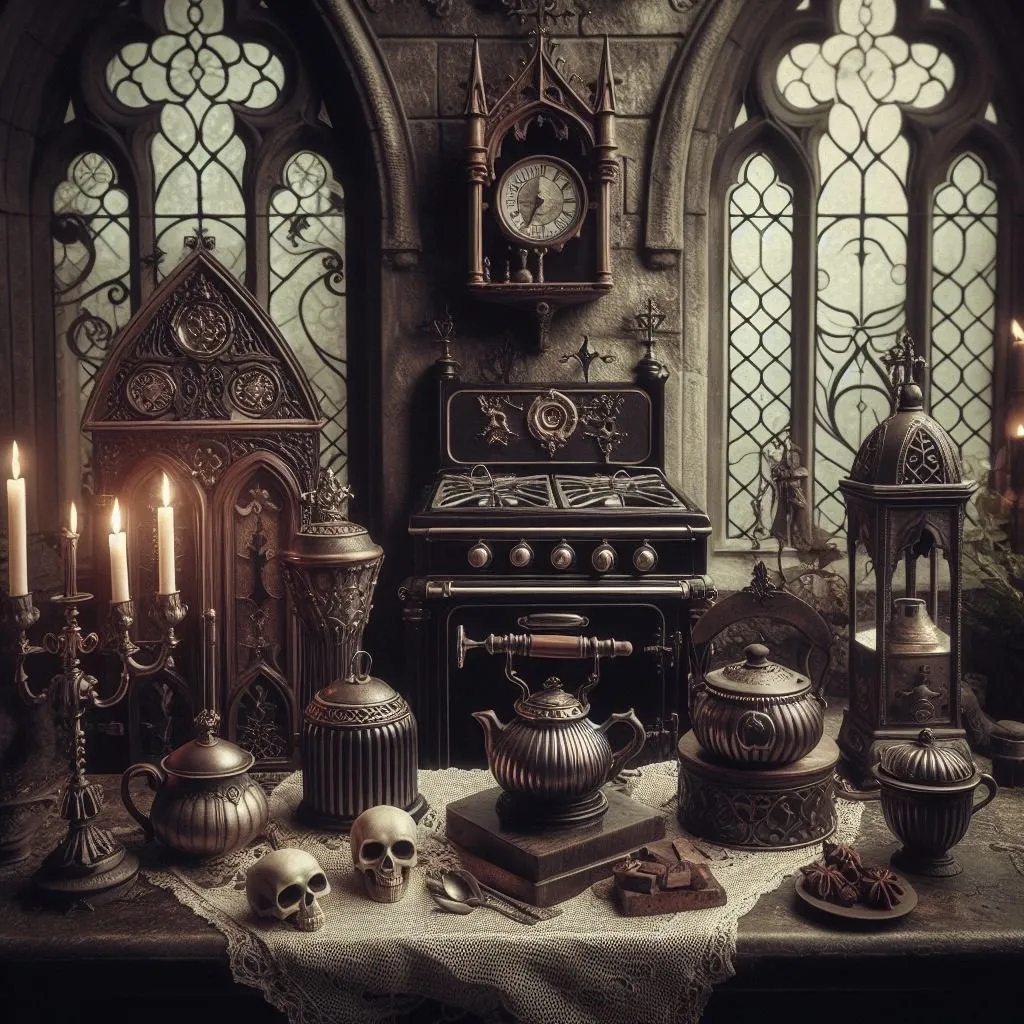
Modern gothic style blends the dark and dramatic elements of gothic design with contemporary simplicity. This version balances the dark with lighter elements, creating a more streamlined look. It often features sleek cabinetry, minimalist hardware, and a mix of textures. The color palettes incorporate dark tones, with a focus on black, gray, and deep blues. The style incorporates modern materials like stainless steel and glass. This style maintains the dark, mysterious atmosphere of traditional gothic, but with a contemporary twist. Modern Gothic is ideal if you prefer a more minimalist approach while still keeping a touch of the gothic aesthetic.
Rustic Gothic
Rustic gothic style combines the dramatic elements of gothic design with the warmth and natural textures of rustic decor. This style often includes distressed wood, exposed brick, and wrought iron accents. Expect a color palette with earthy tones alongside the traditional gothic hues. The use of natural materials and vintage-inspired elements creates a warm, inviting space with a touch of drama. This style is perfect if you appreciate the gothic aesthetic but want a more casual, lived-in feel. This style brings together a blend of old-world charm and natural, rustic appeal. This version of gothic adds a warm and inviting atmosphere.
Essential Gothic Kitchen Elements
When designing a gothic kitchen, there are several essential elements you’ll need to consider. Incorporating these elements into your kitchen design will help you achieve a cohesive and authentic gothic aesthetic. Cabinets and countertops, lighting fixtures, and hardware and accessories are crucial components. These elements set the foundation for your gothic kitchen, and they provide opportunities to introduce the key elements of the gothic style, such as dark colors, ornate details, and textured surfaces.
Cabinets and Countertops
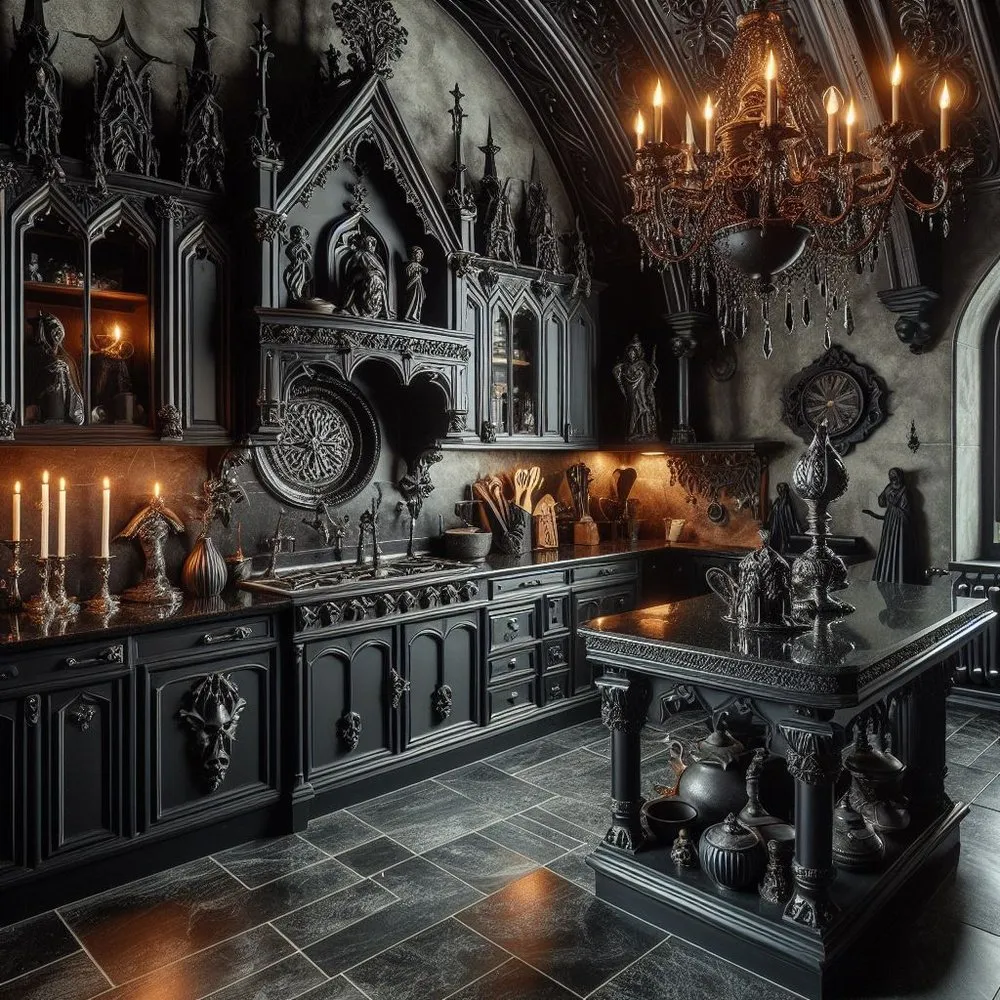
Cabinets and countertops form the foundation of your kitchen design. For a gothic kitchen, consider cabinets in dark wood finishes or painted in deep, moody colors. Cabinets with intricate carvings, paneling, or molding details will enhance the gothic aesthetic. Dark granite, marble, or quartz countertops are also ideal choices. These materials add sophistication and drama, and the dark tones create a cohesive look. To bring a gothic atmosphere to life, choose cabinets and countertops that feature the key elements of the Gothic style. These key design choices will set the mood for your space. You can also explore adding antique or vintage cabinet handles and knobs.
Lighting Fixtures
Lighting is key to setting the mood in a gothic kitchen. Choose fixtures that provide both functional and atmospheric lighting. Consider chandeliers with wrought iron or crystal accents. Pendant lights with dark metal finishes or intricate designs can also add drama. Strategically placed spotlights can highlight architectural details or artwork. Candles, both real and battery-operated, can also be used to create a warm, inviting glow. The lighting is a way to create an atmosphere, casting shadows and adding depth to your space. By focusing on these features, you can create a kitchen that is both functional and enchanting, establishing an ideal gothic atmosphere.
Hardware and Accessories
Hardware and accessories are crucial for bringing the gothic style to life. Opt for cabinet knobs, pulls, and other hardware in wrought iron, antique brass, or dark metal finishes. These details will complement your cabinet design and add character. Consider including accessories like antique mirrors, ornate candle holders, and gothic-inspired artwork. These accessories add personality and make your kitchen feel more unique. Tableware, such as dark-colored plates, vintage silverware, and crystal glassware, can enhance the gothic aesthetic. By focusing on these small details, you can create a cohesive and authentic gothic look.
Decorating Your Gothic Kitchen
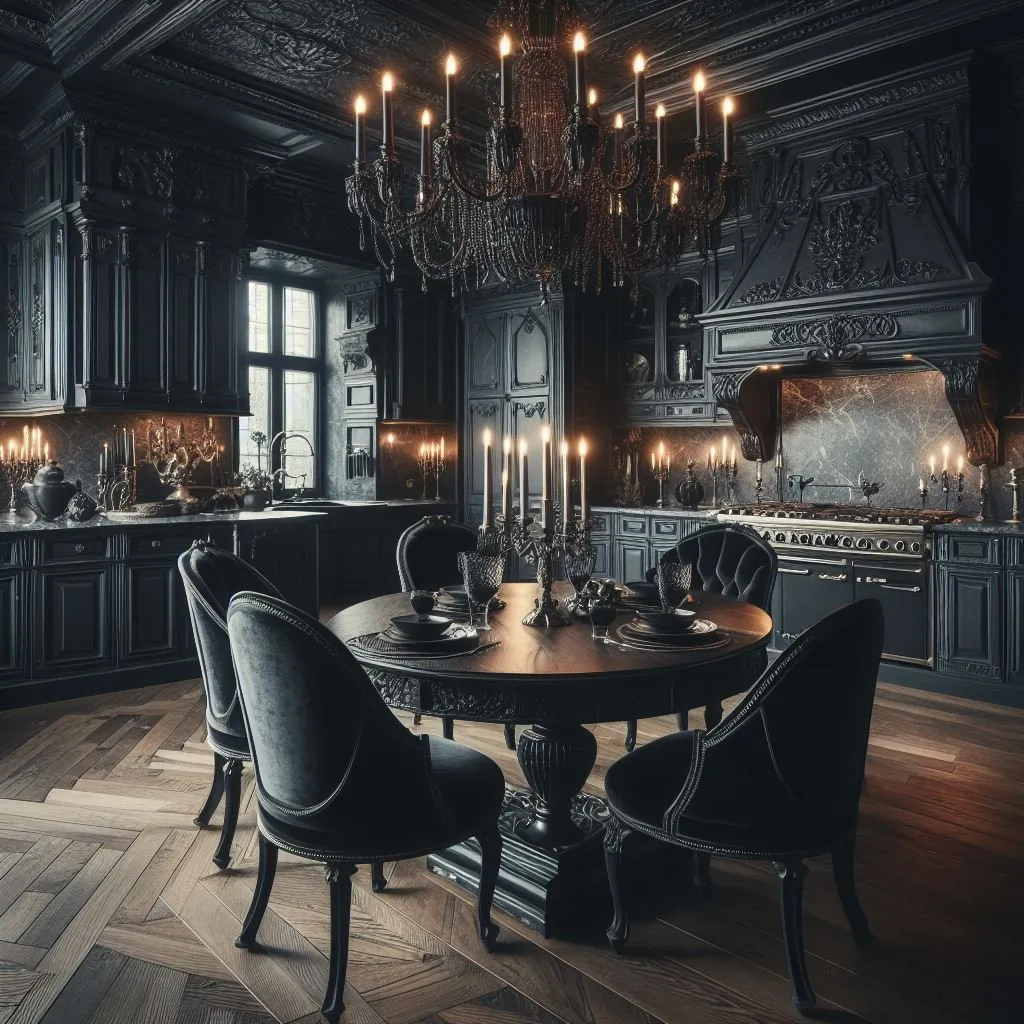
Decorating your gothic kitchen is an opportunity to get creative and incorporate your personal style. Focus on adding details and touches that capture the gothic aesthetic and make your space feel unique. Wall decor, furniture, and tableware are elements that allow you to inject your personality into the design. Remember that the details make all the difference when it comes to the gothic style, so choose items that evoke a sense of drama, mystery, and history. These choices enable you to create a truly personalized gothic kitchen.
Wall Decor Ideas
Wall decor can transform the look and feel of your gothic kitchen. Consider incorporating artwork that reflects the gothic aesthetic. Look for gothic-inspired paintings, prints, or mirrors with ornate frames. You can also add tapestries or wall hangings with intricate patterns or dark themes. Consider incorporating elements like exposed brick or stone walls, which add texture and a sense of history. Add shelves with gothic-inspired decor items, such as antique books, vintage candlesticks, or decorative skulls. These options help you add depth and atmosphere to your kitchen.
Furniture and Seating
Choosing furniture and seating that complements the gothic style is key to creating a cohesive look. Opt for a dining table made of dark wood with ornate details. If space allows, consider including a gothic-style dining set. Chairs with high backs, carved details, or velvet upholstery will add to the dramatic effect. You can also add a bar cart with dark finishes and intricate detailing. Consider adding a kitchen island or a breakfast nook that evokes the gothic style. These furniture and seating choices will make your kitchen both functional and aesthetically pleasing, and will elevate the gothic theme.
Tableware and Linens
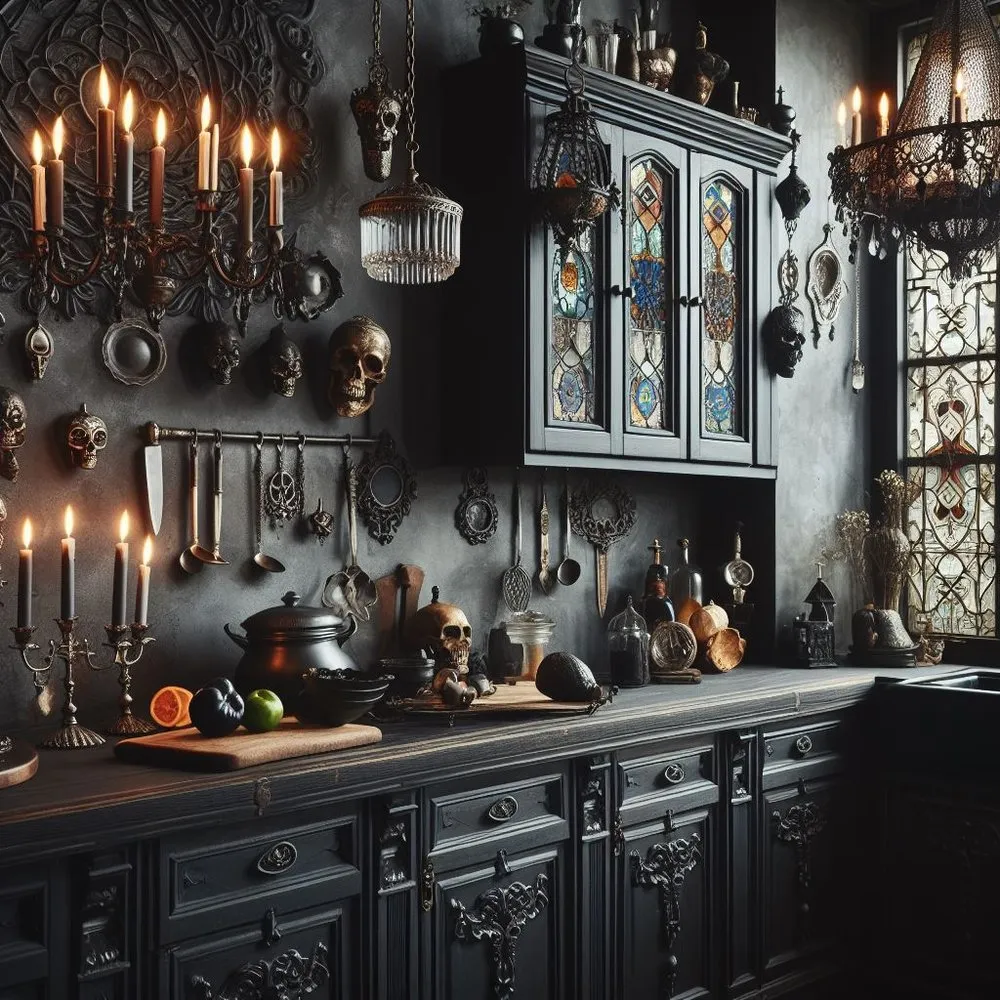
Tableware and linens offer opportunities to enhance the gothic aesthetic in your kitchen. Opt for dark-colored plates, bowls, and serving dishes. Consider using crystal glassware to add elegance and sophistication. Vintage silverware, with intricate detailing, will complement the gothic theme. Linens can include dark-colored tablecloths, napkins, and placemats with patterns or textures that enhance the gothic design. Your tabletop decor allows you to create a gothic atmosphere. These finishing touches will enhance the overall look of your gothic kitchen, creating a space that is both stylish and inviting.
Adding a Spooky Touch
If you’re drawn to the darker side, adding a spooky touch can elevate your gothic kitchen. Consider incorporating these ideas to create a truly unique and thrilling space. Embrace the spookiness and transform your kitchen into a unique reflection of your personal style.
Incorporating Gothic Accents
Gothic accents are the key to bringing this style to life. You can incorporate decorative skulls, antique mirrors, and vintage candelabras. These accents add a touch of drama and mystery. Think about adding gothic-inspired artwork, such as paintings or prints featuring dark landscapes or gothic figures. Place these accents strategically throughout your kitchen to enhance the spooky aesthetic. Use these accents to add a touch of drama and mystery to your kitchen. By thoughtfully incorporating these details, you’ll transform your kitchen into a captivating gothic space.
Finding Inspiration and Resources
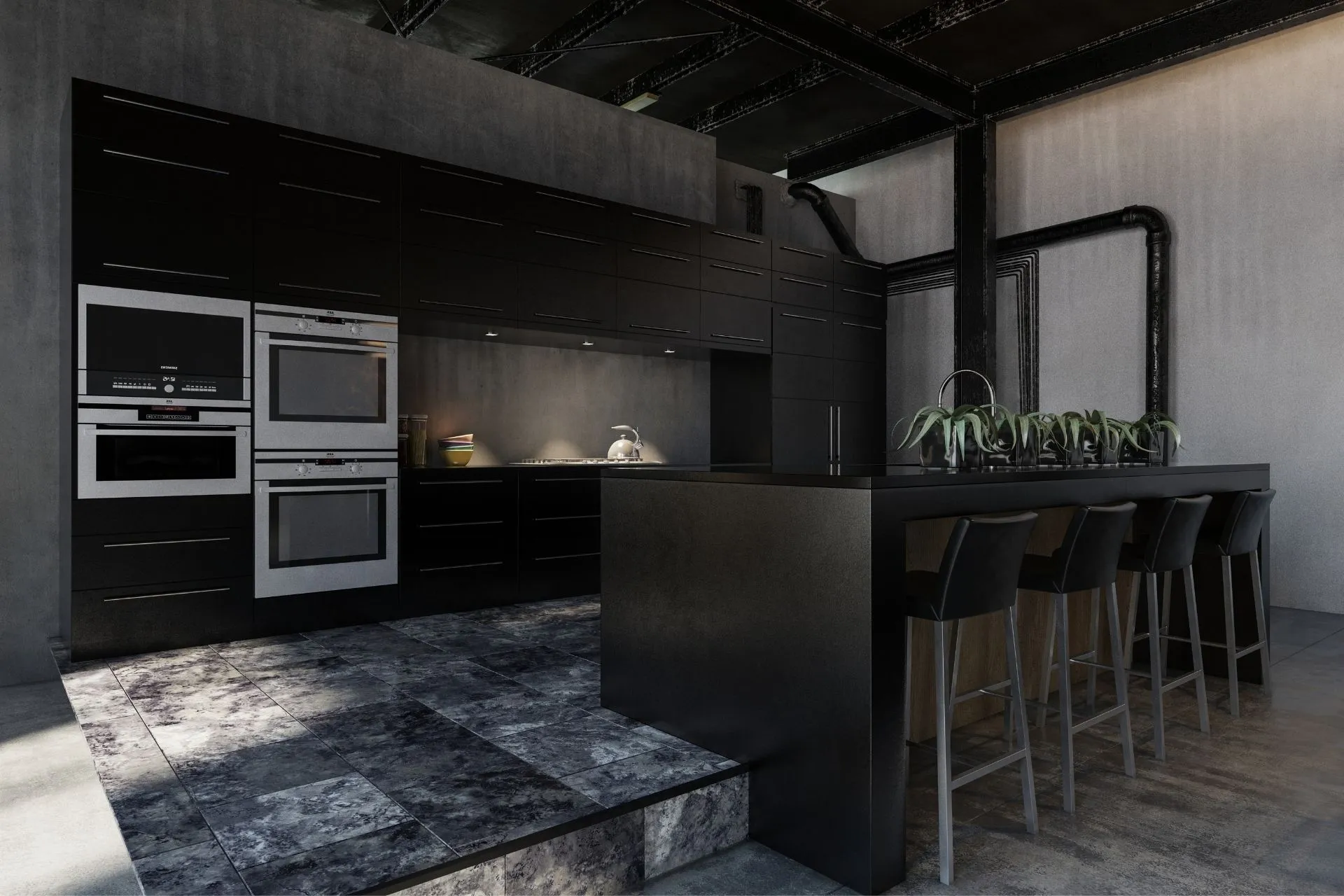
Finding inspiration and resources is key to a successful gothic kitchen design. Utilize online platforms, specialty shops, and DIY projects. These resources will offer you a broad range of ideas, products, and inspiration. By tapping into these resources, you can start your gothic kitchen project with confidence.
Online Marketplaces
Online marketplaces are great sources for gothic kitchen decor. Sites like Etsy and eBay offer a wide variety of vintage, antique, and handmade items. You can also find gothic-inspired furniture, decor, and accessories. Utilize these platforms to discover unique, hard-to-find items that will add character to your kitchen. Look for sellers that specialize in gothic decor or vintage finds. These platforms provide you with an opportunity to find unique items that reflect your personal style.
Specialty Shops and Boutiques
Specialty shops and boutiques are excellent resources for gothic kitchen decor. Visit antique stores, vintage shops, and decor boutiques. These stores often have a curated selection of unique items. You can also visit shops that specialize in gothic or alternative decor. These specialty stores can offer personalized advice. These shops give you the opportunity to discover the best items for your kitchen.
DIY Projects
DIY projects can be an economical and fun way to customize your gothic kitchen. Consider repainting your cabinets or furniture in dark, moody colors. You can also create your own wall art or decor items. Refurbishing antique or vintage finds can be a rewarding project. DIY projects give you the opportunity to get creative and personalize your kitchen. These DIY projects add a unique touch. DIY projects are a fun way to design your gothic kitchen.
